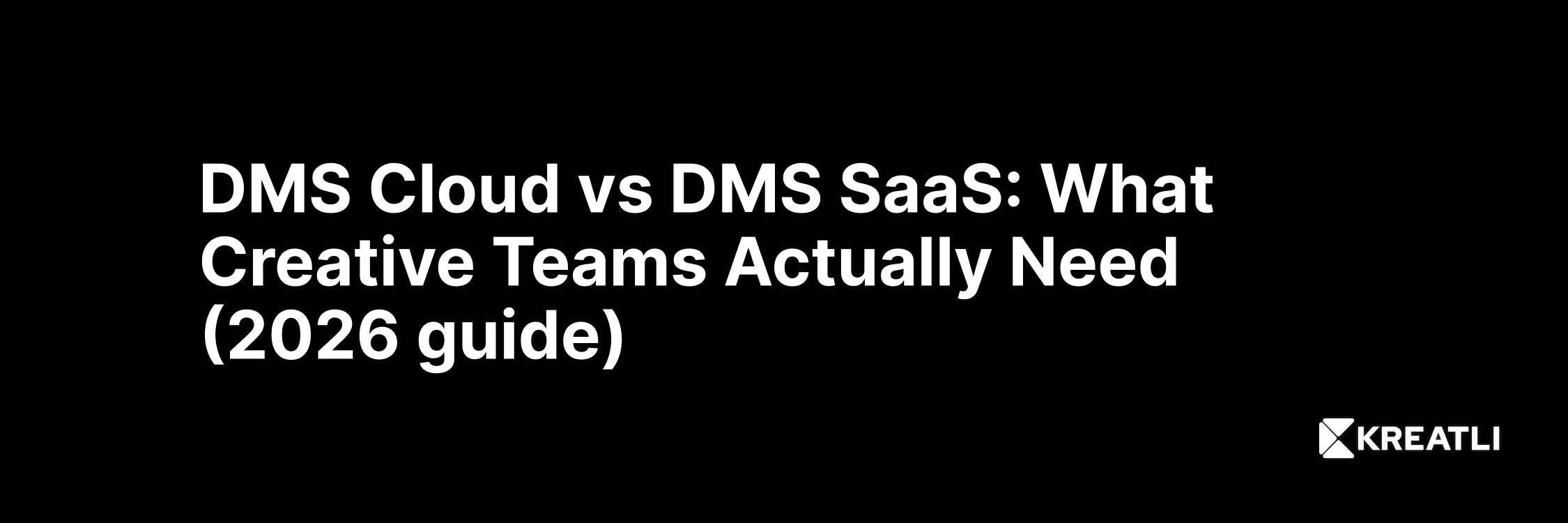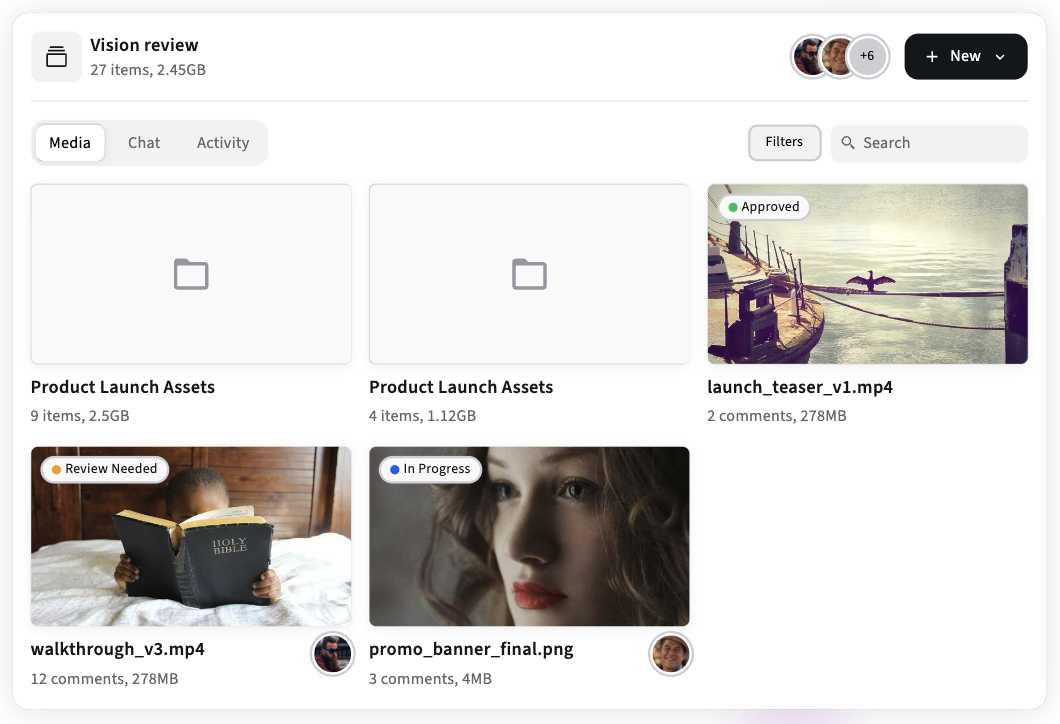DMS Cloud vs DMS SaaS: What Creative Teams Actually Need (2026 guide)
DMS cloud vs DMS SaaS explained for creative teams: costs, security, proxy and NLE integration, migration checklist and a practical pilot plan. Includes vendor questions and how Kreatli pairs with your DMS.

TL;DR
If you want low ops, predictable updates, and fast onboarding for multi-site teams, DMS SaaS (multi-tenant) is usually the better choice. SaaS vendors handle upgrades, security patches, and scale.
If you need deep control over data residency, custom integrations at the OS level, or strict on-prem compliance, a cloud-hosted (self-managed) DMS may be better - but be prepared for higher operational cost and longer deployment.
Creative teams often benefit from a hybrid: DMS SaaS for document and review flows, plus production management platforms (e.g., Kreatli) that link reviews, proxies and approvals to the DMS for long-term governance.
What we mean by “DMS cloud” and “DMS SaaS”
DMS cloud (self-managed in the cloud): you run the DMS software in a cloud IaaS (e.g., on AWS/Azure) but retain control of configuration, updates, and often the underlying storage. This model gives control but requires ops expertise. LogicalDOC
DMS SaaS (software-as-a-service): the vendor hosts and manages the whole stack (multi-tenant or single-tenant options). You subscribe, configure, and use vendor-managed admin controls and APIs. This minimizes customer ops work and accelerates deployment. Box
Both models are “cloud” in the sense that services are internet-accessible - the difference is who owns the operational burden.
Why the distinction matters for creative teams
Creative workflows are special: huge files, proxy playback, many external reviewers, and heavy reuse of assets. Those constraints mean your DMS must do more than store documents - it must integrate into an editorial pipeline and support proxy-first review workflows.
Key considerations for creative teams:
Proxy & streaming support (so clients can review without downloading huge masters).
Integration with NLEs and review tools to import markers and roundtrip notes.
Guest reviewer flows with easy UX and fine-grained permissions.
Retention, legal holds, and audit trails for post-production deliverables.
Cost predictability for storage and egress, because video egress can be expensive.
SaaS DMS vendors commonly provide ready-built capabilities (co-authoring, admin consoles, audit logs) that map well to these needs - but verify proxy playback and NLE integration specifically, because many generic DMS products are document-first rather than media-first. Box
Pros & Cons
Factor | DMS SaaS | Cloud-hosted / Self-managed |
|---|---|---|
Time to value | Fast - vendor handles hosting & upgrades. | Slower - you provision infra and manage updates. |
Operational burden | Low | High |
Customization | Limited to vendor APIs/config | High - full control |
Data residency & compliance | Varies - ask about region options | Full control over region & storage |
Cost predictability | Subscription model (easier to forecast) | More variables - infra + ops + storage egress |
Scale for media | Depends on vendor - check proxy/transcode features | You control scale but pay for infra + ops |
Real-world scenarios - which model fits you
Freelancers / solo creators
Use SaaS DMS or even consumer-first cloud storage: low overhead, fast sharing, and easy link-based review. Avoid heavy infrastructure costs.
Small studios / agencies (2–50 people)
SaaS DMS + a project-first workspace (for reviews & proxies) is attractive - you get admin consoles, guest flows, and predictable costs without hiring ops. Verify that the SaaS product supports proxy streaming and integrates with your review tools. Box
Large studios / broadcasters
Often combine on-prem or cloud-hosted DMS with specialized MAM/DAM systems to meet regulatory, performance, and integration needs. Expect to run dedicated storage and transfer tooling (accelerated transfers for OB/inbound media). LogicalDOC
Security & governance - questions to ask any vendor
When evaluating any DMS model (SaaS or self-managed), ask for:
Data residency & region options - can the vendor host your data in your region? (critical for EU/UK/GDPR).
Encryption - in transit and at rest, with customer-managed keys if needed.
SSO & MFA support - SAML/SCIM for provisioning and SSO, plus MFA.
Audit logs & eDiscovery - exportable logs and retention/hold controls for legal holds. Google
Upgrade & incident SLA - how does the vendor handle upgrades and rollbacks? What is the incident response time? Box
Box, Microsoft OneDrive, and Google Workspace all expose admin consoles and security controls suitable for many organizations; read each vendor’s admin docs to confirm they meet your governance needs.
Integration & media workflows
A DMS that’s great at documents may still fail creative teams if it doesn’t support:
Proxy generation or a smooth way to attach proxies to DMS records.
Marker and comment roundtrips between review platforms and NLEs.
Transfer automation (webhooks) so master ingest triggers proxy creation and populates review workspaces.
A common, pragmatic architecture is:
Use DMS SaaS for document governance and long-term storage of approved deliverables.
Use a production management platform (like Kreatli) for day-to-day review, proxies, and approvals so review context and comments live with the project.
Use accelerated transfer or cloud uploads to move masters into the DMS for archive/delivery when needed. Box
Migration checklist - moving from on-prem or consumer cloud to a DMS SaaS
Pre-migration (discovery)
Inventory storage & workflows (where are masters, proxies, and docs?).
Identify stakeholders and map required integrations (NLEs, review tools, billing).
Choose compliance requirements & retention rules.
Pilot migration
Pick a low-risk project (3–5 assets + metadata) and migrate into a staging tenant.
Validate metadata mapping, proxy linkage, and permission templates.
Test content restore and eDiscovery exports.
Rollout
Migrate projects in waves. Keep a read-only mirror until cutover.
Train users on new guest flows and how to create timecode-pinned comments (if relevant).
Monitor KPIs: time-to-first-comment, review rounds, and failed transfer rates.
Post-migration
Enable audit logs and retention policies.
Archive cleanup: apply lifecycle rules to move inactive masters to cheaper cold storage.
Use vendor implementation guides (Box has dedicated implementation docs and guides) and admin consoles to configure governance and folder structure.
Cost modeling - what to include
Subscription fees (SaaS seats).
Storage fees (active vs archive).
Egress fees (for frequent deliveries).
Transfer/ingest costs (MASV, Aspera) if you often move TBs.
Ops staff or vendor professional services for large migrations.
Be conservative on egress - that’s where surprise bills often occur.
How Kreatli fits
Kreatli is a end-to-end production management platform that pairs well with DMS choices: use Kreatli to host proxy-first review pages, collect frame-accurate comments, and keep approvals. When a version is approved, push the final master and metadata into your DMS (SaaS or self-managed) for archival and governance. This pattern keeps day-to-day collaboration fast while preserving auditability and long-term retention in the DMS. Kreatli
Pilot plan - 6-week validation
Week 0: Discovery & KPI baseline (current review rounds, time-to-approval)
Week 1–2: Configure vendor tenant, set permission templates, create a staging project in Kreatli and link it to the DMS.
Week 3–4: Run 2 live projects through the integrated flow (proxy → review in Kreatli → approve → push master to DMS). Measure time-to-first-comment and review rounds.
Week 5: Fix integration issues and permission gaps.
Week 6: Decide cutover strategy and run archival policy tests.
FAQ
Q: Is DMS SaaS less secure than self-hosted?
A: Not necessarily. Major SaaS vendors offer enterprise-grade security, region options, and SSO; the difference is who operates and patches the system. Ask for encryption, SSO, and audit log capabilities.
Q: Will a DMS replace my MAM/DAM?
A: No - for video-first use cases you will often combine a DMS (for documents, versions, and governance) with a MAM/DAM optimized for media. Use integrations to maintain a single source of truth.
Q: What if I need to move vendors later?
A: Insist on metadata export and API access. Keep sidecar files and export policies so you can migrate metadata and content when needed.
Conclusion
For most creative teams the fastest path to value is DMS SaaS + a project-first review workspace. SaaS reduces ops burden, accelerates onboarding, and keeps governance consistent. Pair the SaaS DMS with a project workspace for proxy-first reviews and then push final masters to the DMS for archival and compliance.
Can Kreatli become your Production Management Platform?
Host proxies, collect frame-accurate comments and measure your first pilot’s ROI.
